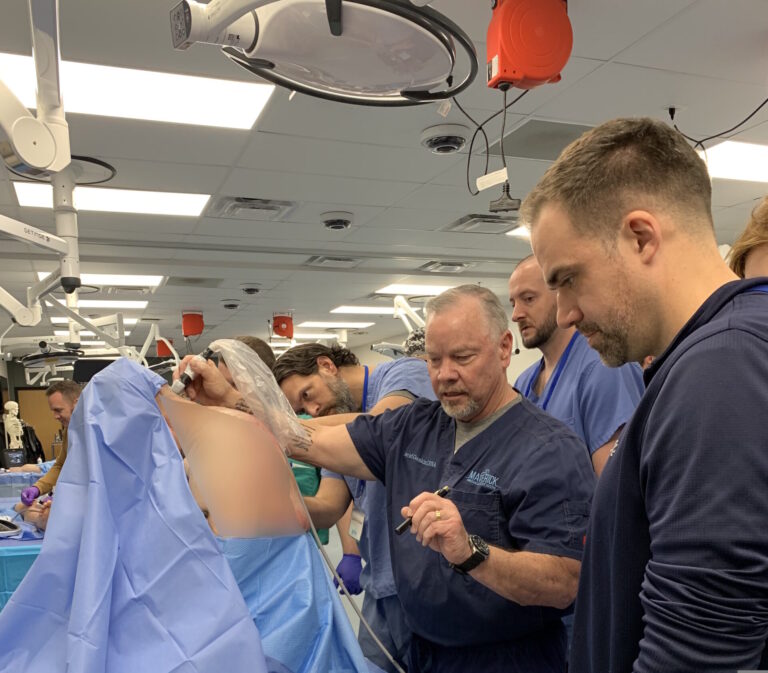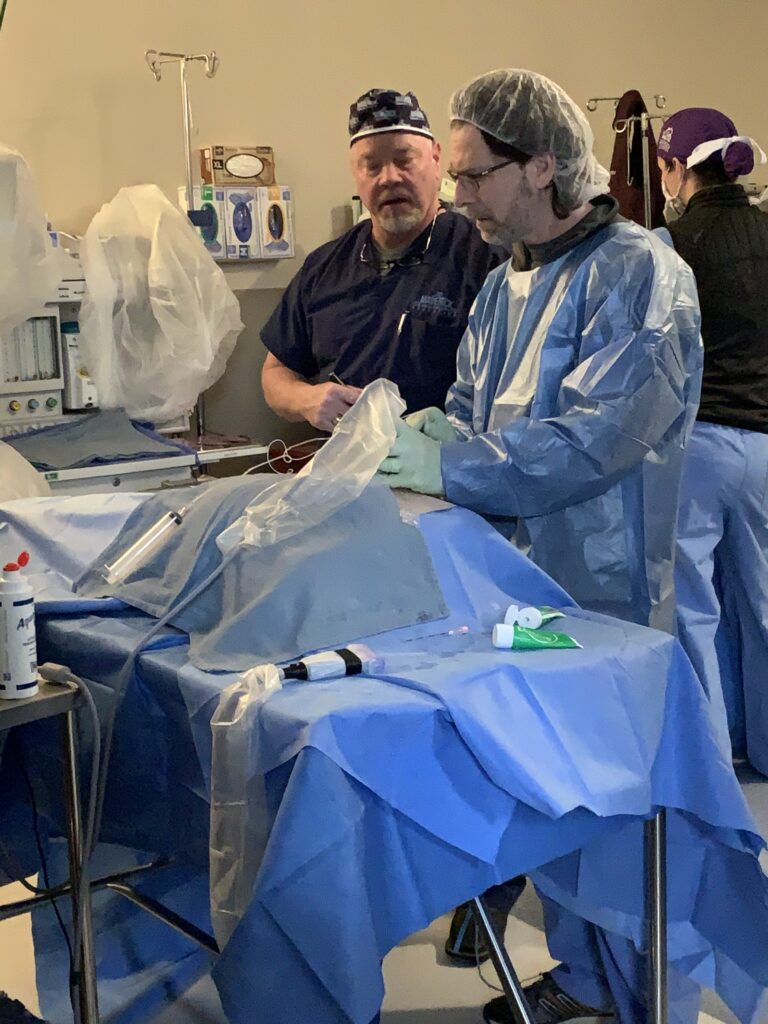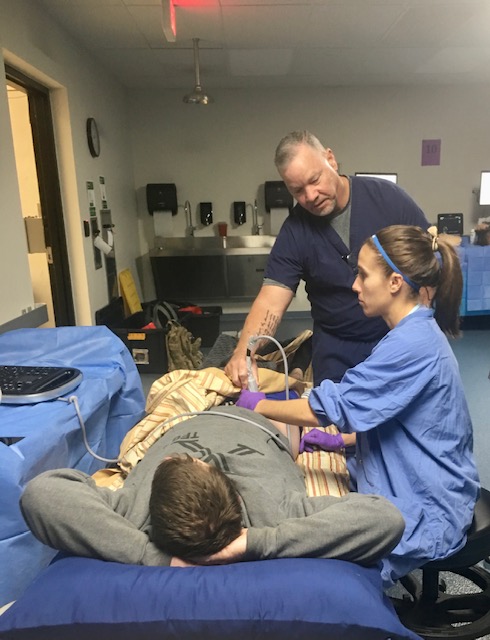
From Cowboy to Nurse Anesthetist
David Gaskin ’93, CRNA (’19 TCU Advanced Pain Management Fellowship Certificate) was born in Dallas but grew up in rural central Texas on a small ranch where he discovered his love of the outdoors and horses. After high school, he worked in a local steel mill and broke horses for professional trainers in his spare time and eventually found himself riding bulls on amateur rodeo circuits. By now, you must be wondering how this cowboy ended up at TCU.
“Bull riding injuries resulted in several surgeries and forced me to find a new source of income for my wife and now three children,” Gaskin said. “After much thought and prayer, we moved from our small hometown of Buffalo, Texas to Fort Worth to begin my nursing education.”
Gaskin enrolled at TCU in the fall of 1990 where he graduated with his Bachelor of Science in nursing three years later. After graduating, he was accepted to the prestigious Surgical Trauma Intensive Care Unit (ICU) nursing residency where he excelled and quickly became the charge nurse of that unit.
“While working in the ICU, I witnessed the intense work of CRNAs and the advanced knowledge required to keep surgical trauma patients safe during a particularly life-threatening time,” Gaskin explains.
Aspiring to further his education, Gaskin enrolled in the Texas Wesleyan University nurse anesthesia program where he graduated with his Master of Health Science degree in 1996 and became a certified registered nurse anesthetist (CRNA) two years later and eventually moved to College Station, Texas to begin his nurse anesthesia career.
From geriatric to pediatric patients, Gaskin navigated the many nuances of providing anesthesia to various types of patients and quickly learned that a regional nerve block would provide superior analgesia for patients. Analgesia is the relief of pain without the loss of consciousness or sensation using analgesics, such as Aspirin. Whereas anesthesia is the loss of physical sensation with or without loss of consciousness using anesthetics.
“I sought to find the safest, most effective means of providing anesthesia.”
Little did he know it would become his passion.

A Career in Innovation
Gaskin’s knowledge and expertise in peripheral nerve blockage grew rapidly. He formed an education company with co-worker Dan Nash, Maverick Medical Education, where they teach other CNRAs how to administer peripheral nerve blocks safely and effectively.
“Maverick was started simply to help train student nurse anesthetists before beginning their clinical rotations with us in the hospital,” explains Gaskin. “We learned through experience that students learn best by doing – not watching.”
However, allowing students to “learn” on a live patient was not optimal, so they established Maverick Medical Education to allow students to gain critical experience in a stress-free environment. They soon found that working CRNAs needed that learning environment also.
Because of this, Gaskin and Nash developed a high-fidelity simulation of ultrasound training in which a human cadaver specimen is made pulsatile. The replication of live human anatomy allows the student to hone their anatomy recognition and perfect their needle-driving skills in a controlled environment. Their concept was awarded two U.S. patents in 2022 for its originality.
In 2018, Gaskin continued advancing his education in the treatment of pain through the TCU School of Nurse Anesthesia’s Advanced Nonsurgical Pain Management Fellowship, becoming one of the first 50 advanced practice registered nurses (APRN) in the U.S. to obtain board certification in Non-Surgical Pain Management (NSPM-C), a subspecialty board certification in pain management for CRNAs.
The following year, Gaskin opened a private pain management practice, Republic Pain Specialists, the first office-based pain practice owned and operated by an APRN in the state of Texas.

Long COVID Syndrome
Through Republic Pain Specialists, Gaskin treats all types of cervical, thoracic and lumbar spinal pathologies including all manner of peripheral nerve entrapments, degenerative joints, migraine headaches and many other unusual pain pathologies with ultrasound-guided injections or neurolysis techniques.
One of these unusual pathologies is what’s known as Long COVID. Gaskin explains after a bout of COVID-19, a patient will experience debilitating fatigue, mental fogginess, difficulty concentrating, elevated resting heart rate, dyspnea, persistent cough, dizziness with standing, sleep disturbance, increased anxiety and depression, and a lack of appetite and food aversion due to diminished and altered sense of taste and smell. So, Gaskin introduced the technique of a Stellate Ganglion block (SGB).
It is believed the overreacting positive feedback loop of the neuro-immune-inflammation cascade is involved in the malfunction of the autonomic nervous system, predominantly the sympathetic nervous system, resulting in the constellation of long COVID symptoms. An interruption of this positive feedback loop, by an SGB, can allow a “reset” and the opportunity for the body to reorganize itself through autoregulation and potentially eliminate the symptoms.
Gaskin has performed over 1,400 SGBs during 2022 with a success rate of over 85% for patients from all over the U.S. and as far away as Germany, Israel, South Africa, Kenya, Finland, the United Kingdom, Canada and Scotland.
Republic has partnered with the TCU Advanced Pain Management program to publish the results of their treatments, with the first publication currently under peer review.

Leading On in Education and Healing
Gaskin distinctly remembers his professors in undergraduate nursing stressing to them that they would be expected to become leaders in their hospitals – charge nurses, clinical educators and department managers.
“I have always felt that TCU prepared me well from a didactic and clinical standpoint to excel in the nursing profession, but the mentality that I was expected to lead my profession always impressed me and has never left me,” said Gaskin.
Gaskin said it is extremely rewarding to look back and see the success of both his businesses after many years of building. “Despite the many long days and an untold number of weekends worked, before either business showed a profit, I would not trade the experience for anything in the world.”
Words of Wisdom
To any aspiring health care entrepreneur, Gaskin wants you to know that “the world is at your feet! Just take it.” He also reminds us of how customer service can truly go a long way.
“It seems to be a forgotten idea in the business world. It is my opinion that if we provide a solution where there is a genuine need and treat those customers like they are our family, then we will be a success.”